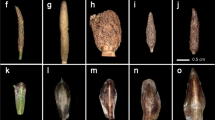Summary
-
1.
For 79 North American populations of the N. Hemisphere polyploid complexAchillea millefolium agg. (Asteraceae-Anthemideae) new tetraploid and hexaploid chromosome counts (n=18, 27 resp. 2 n=36, 54) are documented.
-
2.
Together with literature references this adds to our knowledge of the distribution and affinities ofA. millefolium agg. cytotypes and races in North America. While 4 x types are widespread, autochthonous 6 x are found only in the W (California, and Oregon to southern Brit. Columbia), NW and NE.
-
3.
More remarkable details concern relic 4 x races in coastal California, a subalpine 6 x ecotype in the N. Californian Coast Ranges, evidence for 4 x (apart from 6 x) in Alaska, and the sympatric occurrence (and hybridization?!) of introduced and evidently native 6 x on the Gaspé Peninsula.
-
4.
The groups of disjunct 6 x races quite certainly have originated independently from each other, and — at least partly — directly from adjacent 4 x. Classification of all native North American 4 x as “A. lanulosa Nutt.” and of all 6 x as “A. borealis Bong.” is unnatural and impracticable.
Zusammenfassung
-
1.
Für 79 nordamerikanische Populationen des nordhemisphärischen PolyploidkomplexesAchillea millefolium agg. (Asteraceae-Anthemideae) werden neue tetraploide und hexaploide Chromosomenzählungen (n=18, 27 bzw. 2 n=36, 54) mitgeteilt.
-
2.
Ein Vergleich mit den bisherigen Angaben ergibt ein besser abgerundetes Bild von der Verbreitung und abgestuften Ähnlichkeit der Cytotypen und Rassen vonA. millefolium agg. in Nordamerika. Während 4 x-Sippen weitverbreitet sind, finden sich bodenständige 6 x nur im W (Kalifornien sowie Oregon bis südl. Brit. Columbia), im NW und im NE.
-
3.
Besonders bemerkenswert sind reliktäre 4 x-Sippen im küstennahen Kalifornien, eine subalpine 6 x-Rasse der N. Californian Coast Ranges, der Nachweis von 4 x (neben 6 x) für Alaska und das Nebeneinander (sowie die Bastardierung?!) von eingeschleppten und offenbar bodenständigen 6 x auf der Gaspé-Halbinsel.
-
4.
Die disjunkten 6 x-Sippengruppen sind wohl sicher unabhängig voneinander und zumindest teilweise direkt aus benachbarten 4 x-Sippen entstanden. Die Einstufung aller bodenständigen nordamerikanischen 4 x als „A. lanuloa Nutt.“ und aller 6 x als „A. borealis Bong“. ist unnatürlich und praktisch undurchführbar.
Similar content being viewed by others
References
Calder, J. A., andR. L. Taylor, 1968: Flora of the Queen Charlotte Islands. Queen's Printer, Ottawa 1968.
Clausen, J., D. D.Keck, and W. M.Hiesey, 1940: Experimental studies on the nature of species. Carnegie Inst. Publ.520.
- - - 1948: Experimental studies on the nature of species. Carnegie Inst. Wash. Publ.581.
Ehrendorfer, F., 1952: Cytotaxonomic studies inAchillea. Carnegie Inst. Wash. Yearbook51, 125–131.
—, 1953: Systematische und zytogenetische Untersuchungen an europäischen Rassen desAchillea millefolium-Komplexes. (Vorläufige Mitt.) Österr. Bot. Z.100, 583–592.
—, 1959 a: Spindeldefekte, mangelhafte Zellwandbildung und andere Meiosestörungen bei polyploiden Sippen desAchillea millefolium-Komplexes. Zur Phylogenie der GattungAchillea, III. Chromosoma10, 461–481.
—, 1959 b: Unterschiedliche Störungssyndrome der Meiose bei diploiden und polyploiden Sippen desAchillea millefolium-Komplexes und ihre Bedeutung für die Mikro-Evolution. Zur Phylogenie der GattungAchillea, IV. Chromosoma10, 482–496.
—, 1959 c: Differentiation-hybridization cycles and polyploidy inAchillea. Cold Spring Harb. Symp. Quant. Biol.24, 141–152.
Ehrle, E. B., 1958: A cytotaxonomic study of the genusAchillea in Pennsylvania. Rhodora60, 7–9.
Ferris, R. S., 1958: Taxonomic notes on western plants. Contr. Dudley Herb.5, 99–108.
Hedberg, O., 1967: Chromosome numbers of vascular plants from arctic and subarctic North America. Ark. Bot., ser. 2,6, 309–326.
Hiesey, W. M., andM. A. Nobs, 1970: Genetic and transplant studies on contrasting species and ecological races of theAchillea millefolium complex. Bot. Gaz.131, 245–259.
Hultén, E., 1968: Flora of Alaska and neighbouring territories. Stanford Univ. Press, Calif.
Jones, S. B., 1968: Chromosome numbers in Southeastern United States Compositae, II. Bull. Torrey Bot. Club95, 488–494.
De Jong, D. C. D., andE. K. Longpre, 1963: Chromosome studies in Mexican Compositae. Rhodora65, 225–240.
Lawrence, W. E., 1947: Chromosome numbers inAchillea in relation to geographic distribution. Amer. J. Bot.34, 538–545.
Löve, A., andD. Löve, 1966: Cytotyxonomy of the alpine vascular plants of Mt. Washington. Univ. Colorado Stud., Ser. Biol.24, 1–74.
—, andJ. C. Ritchie, 1966: Chromosome numbers from central Northern Canada. Canad. J. Bot.44, 429–439.
—, andO. T. Solbrig, 1964: IOPB chromosome number reports. I. Taxon13, 99–110.
Mickelson, C. J., andH. H. Iltis, 1966: Preliminary reports on the flora of Wisconsin, No. 55. Compositae IV—Composite family IV (tribes Helenieae and Anthemideae). Wisc. Acad. Sci. Arts Lett.55, 187–222.
Mulligan, G. A., andI. J. Bassett, 1959:Achillea millefolium complex in Canada and portions of the United States. Canad. J. Bot.37, 73–79.
Münz, P. A., andD. D. Keck, 1968: A California flora. Berkeley and Los Angeles, Univ. Calif. Press.
Nobs, M. A., 1960:Achillea. In: L. Abrams and R. S. Ferris: Illustrated Flora of the Pacific States, Washington, Oregon and California,4, 390–391. Stanford Univ. Press.
Raven, P. H., 1963: A flora of San Clemente Island, California. Aliso5, 289–347.
Schneider, Irmfried, 1958: Zytogenetische Untersuchungen an Sippen des Polyploid-KomplexesAchillea millefolium L. s. lat. (Zur Phylogenie der GattungAchillea, I). Österr. Bot. Z.105, 111–158.
Smolenski, S. J., C. L. Bell, andL. Bauer, 1967: The isolation of Achillin fromAchillea millefolium. Lloydia30, 144–149.
Suda, Y., andG. W. Argus, 1969: IOPB Chromosome number reports. Taxon18, 221.
Turner, B. L., J. H. Beaman, andH. F. L. Rock, 1961: Chromosome numbers in the Compositae. V. Mexican and Guatemalan species. Rhodora63, 121–129.
Tyrl, R. J., 1967: Cytogeography ofAchillea millefolium L. in Western Oregon. Thesis (Master's degree), Oregon State Univ. Corvallis.
—, 1969: Cytogeography ofAchillea millefolium in Western Oregon. Brittonia21, 215–223.
Author information
Authors and Affiliations
Rights and permissions
About this article
Cite this article
Ehrendorfer, F. New chromosome numbers and remarks on theAchillea millefolium polyploid complex in North America. Osterr bot Z 122, 133–143 (1973). https://doi.org/10.1007/BF01624798
Received:
Issue Date:
DOI: https://doi.org/10.1007/BF01624798




